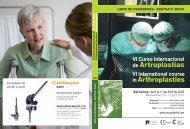cadera / hip - Active Congress.......
cadera / hip - Active Congress.......
cadera / hip - Active Congress.......
Create successful ePaper yourself
Turn your PDF publications into a flip-book with our unique Google optimized e-Paper software.
MARTES / TUESDAY<br />
70<br />
only be used for the older patient of 65 years<br />
or more. Some excellent long term results<br />
have been obtained in patients who had some<br />
other limiting factor from a young age that<br />
prevented them attaining a high mileage each<br />
year. We all know the problems of osteolysis<br />
related to the polythene debris from a metal<br />
on polythene joint. It is for these reasons<br />
there is again a logical argument for using<br />
a metal on metal articulation in the younger<br />
and active patient.<br />
The Outcome Centre at Oswestry has been<br />
following 5000 patients now out to 9 years.<br />
This is an independent review where information<br />
is gathered directly from patients.<br />
This has found a very high level of function<br />
and activity in patients with metal on metal<br />
resurfacing <strong>hip</strong> replacement. There is good<br />
survival out to 9 years with 97% survival at a<br />
minimum of 7 years. This group of patients is<br />
from a combined series of several surgeons<br />
across the world who are new to using this<br />
technique.<br />
Similarly, I have excellent results now out<br />
to 10 years with the Metasul articulation on<br />
a Thrust Plate. This is the shortest possible<br />
uncemented stem with strong initial stability<br />
and rigidity. These patients likewise have a<br />
high level of activity and the 8 year follow up<br />
was 98% survival.<br />
What of the metal ions absorbed? Certainly<br />
in a minority of patients these have a hypersensitivity<br />
response which causes pain and<br />
cyst formation. All patients absorb some<br />
metal in the form of chromium and cobalt.<br />
These levels are highest in the joint and<br />
adjacent to the metal implants. Alterations<br />
in circulating cells have been noted and this<br />
causes concern. However, the observation<br />
of a local sarcoma adjacent to a metal implant<br />
is very rare indeed considering the numbers<br />
implanted worldwide and this includes a<br />
whole range of metal implants. The observation<br />
therefore is that in practice and indeed<br />
over many years it is unlikely that the risk of<br />
a local cancer is signifi cant. Further observations<br />
and studies are needed to identify and<br />
quantify risks of leukaemia.<br />
METAL-METAL BEARING<br />
SURFACES: THE WAY<br />
OF THE FUTURE?<br />
S. J. MacDonald, MD, R. W. Mc-<br />
Calden, MD, R. B. Bourne, M.D.,<br />
C. H. Rorabeck, M.D., D. Chess, M.D.<br />
Health Sciences Centre, Ontario, Canada<br />
Objective: Polyethylene wear continues<br />
to be the most signifi cant issue following<br />
total <strong>hip</strong> arthroplasty (THA) leading to the<br />
current increase in use of alternative bearing<br />
surfaces. We performed a prospective,<br />
randomized, blinded clinical trial comparing<br />
metal versus polyethylene bearing surfaces<br />
in patients receiving THA.<br />
Method: Forty-one patients were randomized<br />
to receive a metal (23) or a polyethylene<br />
(18) insert with identical femoral and acetabular<br />
components. Patients were evaluated<br />
pre-operatively, at 3, 6, 12 months and annually<br />
thereafter, including an evaluation of<br />
erythrocyte and urine cobalt, chromium, and<br />
titanium, outcome measures (WOMAC, SF-<br />
12, Harris Hip Score) and radiographs.<br />
Results: No patients were lost to follow-up.<br />
At an average 7.2 (range 6.1 – 7.8) years<br />
follow-up there were no differences in any<br />
outcome measures or radiographic fi ndings.<br />
Patients receiving metal liners had signifi -<br />
cantly elevated metal ion measurements. At<br />
most recent follow-up erythrocyte cobalt levels<br />
were 7 times elevated (median 1.2 ∗g/L<br />
(metal) vs 0.18 ∗g/L (poly), p





